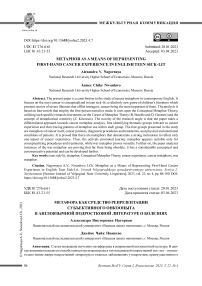Metaphor as a means of representing first-hand cancer experience in English teen sick-lit
Автор: Nagornaya A.V., Nwankwo Ja.ch.
Журнал: Вестник Волгоградского государственного университета. Серия 2: Языкознание @jvolsu-linguistics
Рубрика: Межкультурная коммуникация и сопоставительное изучение языков
Статья в выпуске: 4 т.22, 2023 года.
Бесплатный доступ
The present paper is a contribution to the study of cancer metaphors in contemporary English. It focuses on the ways cancer is conceptualized in teen sick-lit, a relatively new genre of children's literature which presents stories of severe illnesses that afflict teenagers, cancer being the most important of them. The analysis is based on four novels that employ the first-person narrative mode. It rests upon the Conceptual Metaphor Theory, utilizing such specific research instruments as the Career of Metaphor Theory (B. Bowdle and D. Gentner) and the concept of metaphorical creativity (Z. Kovecses). The novelty of the research angle is that the paper takes a differentiated approach towards cancer metaphor analysis, first identifying thematic groups relevant to cancer experience and then tracing patterns of metaphor use within each group. The four groups presented in the study are metaphors of cancer itself, cancer patients, diagnostic procedures and treatments, and physical and emotional conditions of patients. It is proved that there are metaphors that demonstrate a strong inclination to reflect only one aspect of cancer experience. Thus, the actively promoted journey metaphor appears suitable only for conceptualizing procedures and treatments, while war metaphor proves versatile. Further on, the paper analyzes instances of the war metaphor use proving that far from being obsolete, it has a considerable conceptual and communicative potential and can be developed further.
Teen sick-lit, metaphor, conceptual metaphor theory, cancer experience, cancer metaphors, war metaphor
Короткий адрес: https://sciup.org/149143751
IDR: 149143751 | DOI: 10.15688/jvolsu2.2023.4.7
Список литературы Metaphor as a means of representing first-hand cancer experience in English teen sick-lit
- Bowdle B.F., Gentner D., 2005. The Career of Metaphor. Psychological Review, vol. 112, no. 1, рр. 193-216.
- Demjen Z., 2016. Laughing at Cancer: Humour, Empowerment, Solidarity and Coping Online. Journal of Pragmatics, iss. 101, pp. 18-30.
- Elman J.P., 2012. "Nothing Feels as Real": Teen Sick-Lit, Sadness, and the Condition of Adolescence. Journal of Literary & Cultural Disability Studies, vol. 6, iss. 2, pp. 175-191.
- Elman J.P., 2014. Chronic Youth: Disability, Sexuality, and U.S. Media Culture of Rehabilitation. New York, NYU Press. 258 p.
- Frank A., 2013. The Wounded Storyteller: Body, Illness & Ethics. Chicago, The University of Chicago Press. 282 p.
- Hendricks R.K., Demjen Z., Semino E., Boroditsky L., 2019. Emotional Implications of Metaphor: Consequences of Metaphor Framing for Mindset About Cancer. Metaphor and Symbol, vol. 33, no. 4, pp. 267-279.
- Kovecses Z., 2015. Where Metaphors Come from: Reconsidering Context in Metaphor. Oxford, Oxford University Press. 232 p.
- Kumbier A. Trauma Club: The Chronic Popularity of Illness Lit. Bitch Media. URL: https:// www.bitchmedia.org/article/in-sickness/the-popularity-of-illness-lit
- Lakoff G., Johnson M., 1980. Metaphors We Live By. Chicago, University of Chicago Press. 193 p.
- McDaniel L., 2000. Dawn Rochelle, Four Novels. London, Starfire. 544 p.
- Mukherjee S., 2011. The Emperor of All Maladies: A Biography of Cancer. London, Fourth Estate. 597 p.
- Nagornaya A., 2012. Orudiynaya metafora kak sredstvo obyektivatsii vnutritelesnogo opyta [The Weapon Metaphor as a Means of Objectifying Inner-Body Experience]. Vestnik Leningradskogo gosudarstvennogo universiteta imeni A.S. Pushkina [Pushkin Leningrad State University Journal], vol. 7, no. 2, pp. 84-96.
- Nagornaya A., 2013. Smeshannaya metafora kak sredstvo verbalizatsii interotseptivnogo opyta [Mixed Metaphor as a Means of Verbalizing Interoceptive Experience]. Vestnik Orlovskogo gosudarstvennogo universiteta. Seriya: Novye gumanitarnye issledovaniya [Orlov State University Bulletin. Series: New Research in the Humanities], no. 5 (34), pp. 146-151.
- Nagornaya A., 2017. Obrazy zhivotnyh v diskurse vnutritelesnyh oschuschenii [Animal Images in the Discourse of Inner-Body Sensations]. Yazykovoi obraz v kommunikatsii: sbornik nauchnykh trudov [Language Image in Communication. Collection of Scientific Papers]. Moscow, INION RAN Publ., pp. 56-68.
- Nagornaya A., 2021. Ispolzovaniye metafor v psihoterapevticheskoi praktike [The Use of Metaphors in Psychotherapy]. Sotsialnye i gumanitarnye nauki. Otechestvennaya i zarubezhnaya literature. Seriya 6: Yazykoznanie. Referativnyi zhurnal [Social Sciences and Humanities. Russian and Foreign Literature. Series 6: Linguistics. Review Journal], no. 4, pp. 97-120.
- Peet M. Teen Fiction and the Shadow of Cancer. URL: www.theguardian.com/books/2013/jan/26/teen-fiction-cancer-taboo
- Perusek D., 2012. Cancer, Culture, and Individual Experience: Public Discourse and Personal Affliction. Ethos, vol. 40, iss. 4, pp. 476-506.
- Pragglejaz Group, 2007. MIP: A Method for Identifying Metaphorically Used Words in Discourse. Metaphor and Symbol, vol. 22, no. 1, pp. 1-39.
- Rabinow P., 1996. Artificiality and Enlightenment: From Sociobiology to Biosociality. Politix, no. 90 (2), pp. 21-46.
- Rosenberg S.A., 2020. Overcome the Challenges of Cancer Care: How to Avoid Pitfalls on the Path to Healing. Washington, Rowman & Littlefield Publishers. 180 p.
- Semino E., Demjen Z., Hardie A., Payne Sh., Rayson P., 2018. Metaphor, Cancer and the End of Life: A Corpus-Based Study. New York, Routledge. 314 p.
- Sontag S., 1978. Illness as Metaphor. New York, Farrar, Straus and Giroux. 87 p.
- Spelman E.V., 1997. Fruits of Sorrow: Framing our Attention to Suffering. Boston, Beacon Press. 224 p.
- Steen G.J., 2007. Finding Metaphor in Grammar and Usage: A Methodological Analysis of Theory and Research. The Netherlands, John Benjamins Publishing Co. 436 p.
- Testoni I., Parise G., Zamperini A., Visintin E.P., Toniolo E., Vicentini S., De Leo, 2016. The "Sick-Lit" Question and the Death Education Answer. Papageno Versus Werther Effects in Adolescent Suicide Prevention. Human Affairs, vol. 26, no. 2, pp. 153-166.


